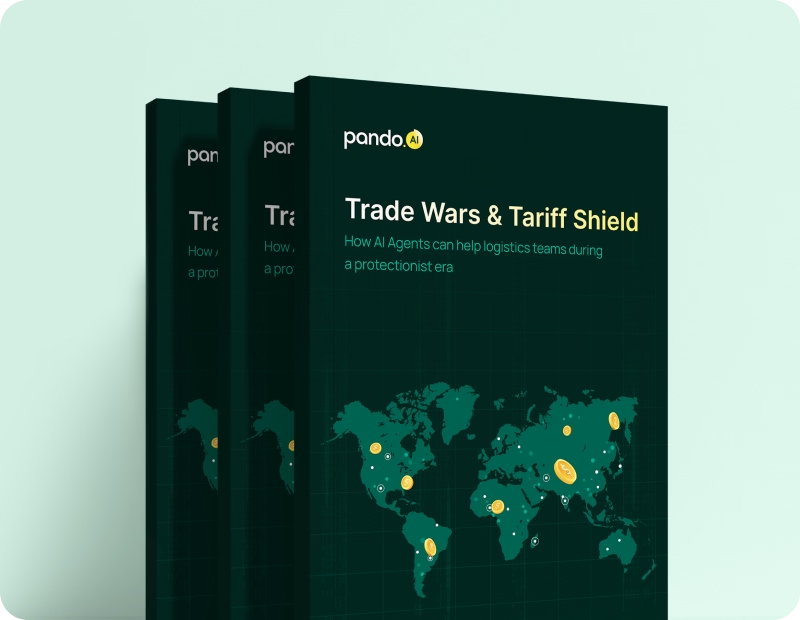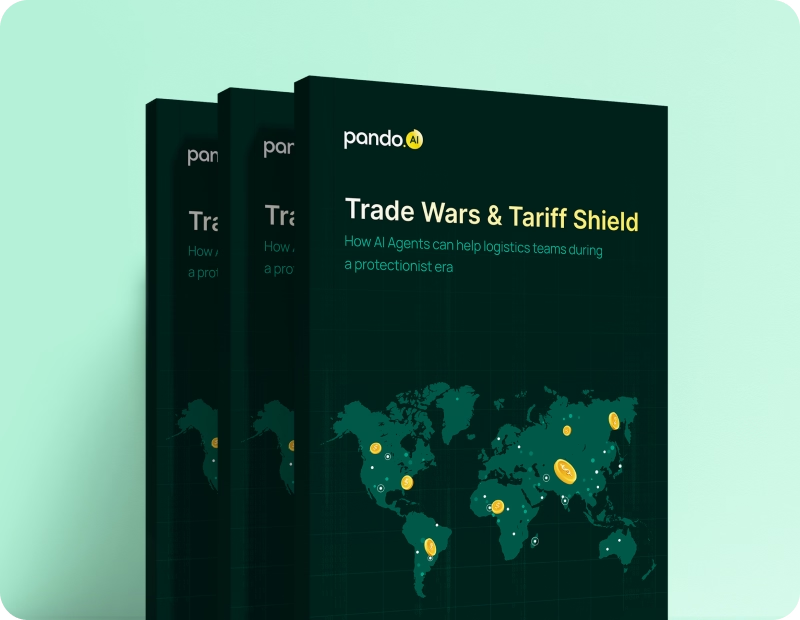-
Products Products
- Industry
- Initiatives
- Resources
- Company
- Book a demo

Before you go: Logistics leaders just dropped the truth on AI
The State of AI in Logistics 2025 is here — no hype, just real conversations and raw insights.
Navigating global challenges: The complexities of international logistics shipments
Overcome global shipping challenges with advanced technology and smarter logistics strategies.
Published on December 4, 2024 • 9 mins read
Rohit Lakshman

Overcome global shipping challenges with advanced technology and smarter logistics strategies.
When shipping any high-value items, whether electronics or perishable goods, every little detail in your supply chain deserves your full attention. The logistics industry is an incredibly complex and diverse industry that is constantly changing. It's a space with challenges, from tightening customs regulations and geopolitical instability to infrastructure constraints. Overcoming these challenges and ensuring deliveries are on point and timely require a strategy powered by precision, foresight, and innovation.
Let's discuss some common cross-border logistic challenges and learn how to handle them with advanced technologies.
The global challenges of managing logistics shipments
Handling logistics shipments on a global scale differs from dealing with domestic freight. Numerous dynamic parameters in play challenge your decision-making power. Let's dive into some similar challenges you might face.
-
Varying customs and import-export regulations
Each country has its unique policies and governance mechanisms when it comes to import-export rules, documentation, and customs. Dealing with all these different rules can slow down your shipments and raise the chances of delays or penalties, and it is so frustrating.
For instance, customs clearance documentation varies widely by country. In some places, a detailed invoice and bill of lading may suffice in some countries, but others may require certificates or permissions. For example, to import in the U.S., you need to submit an arrival notice (with details related to the shipper, like location, consignee, and arrival time), an entry form (with details like country of origin, description, and H.S. code), and an import license.
Similarly, free trade agreements sometimes require commodities to meet rules of origin to receive favorable tariff treatment. A car may need a particular percentage of its value added in the agreement's countries to be declared "made in" that region.
To handle this, you need to implement automated compliance tracking with cutting-edge software platforms like TMS that are equipped for international shipping. This will help you keep an eye on regulations in real time. Ideal automated compliance tracking software seamlessly integrates customs documentation right into your workflow. As a result, you minimize the chances of human errors and ensure shipments breeze through customs without a hitch.
-
Dynamic trade agreements and tariffs
Global trade agreements and tariffs bring another level of global shipping challenges. Shipping costs become unpredictable, with tariffs changing all the time due to international relations and trade laws. It’s a constant challenge to determine the final costs, making it feel like a rollercoaster.
For example, the Houthi group's strikes on cargo ships in the Bab al Mandeb Strait at the southern end of the Red Sea have forced Maersk and B.P. to postpone shipments and halt operations. Ships are now avoiding Egypt's Suez Canal, the quickest maritime route from Europe to Asia and one of the world's most significant waterways, which handles a major marine volume. This increases travel time, expenditures, oil prices, and insurance premiums.
Moreover, the trade wars and tariffs between the U.S. and China also have caused significant disruptions to the global supply chain.
-
Infrastructure limitations
The infrastructure quality of your operating country can affect your delivery deadlines. In underdeveloped and developing countries, logistics companies struggle with bad roads, congested ports, or outdated logistics hubs. These issues can seriously slow things down.
Imagine giving your customers the power to see exactly where your shipments are at any moment. With the combo of IoT and GPS tracking tech, transport management systems offer you this facility. You can use TMS to stay ahead of potential delays, reduce those critical bottlenecks, and boost your overall efficiency.
-
Socioeconomic disruptions
Socioeconomic factors can significantly complicate logistics. Economic downturns, workforce shortages, and infrastructure challenges can disrupt supply chains and increase costs. The COVID-19 pandemic had a profound impact on global supply chains, halting manufacturing, disrupting transportation, and altering consumer demand patterns. Additionally, currency exchange rates can influence import and export prices, adding further complexity.
-
Geopolitical events
Geopolitical events also play a major role in affecting logistics. Trade conflicts, sanctions, and political instability can lead to increased tariffs, trade barriers, and transportation disruptions. For instance, the Russia-Ukrain war has significantly disrupted the supply chain of vital sectors and contributed to elevated inflation. Similarly, regional conflicts can threaten security and hinder trade flows.
-
Natural disasters
Natural disasters like hurricanes, earthquakes, and tsunamis can severely impair logistics operations. These events can damage infrastructure, halt transportation, and disrupt supply chains. The 2011 earthquake in Japan, for example, caused widespread damage to transportation infrastructure and disrupted global supply chains for months.
Exploring how technology transforms cross-border logistics
Conventional logistics methods are becoming more and more inadequate to meet the demands of expanding global trade and e-commerce. However, with the help of technology, global supply chains are now more efficient, transparent, and flexible, which has revolutionized cross-border logistics. In this regard, let's check how the use of cutting-edge technology is enhancing the quality and efficiency of international logistics shipments:
Real-time visibility
When you're handling cross-border logistics, it's super important to keep track of your shipment's exact location at all times, especially with so many stakeholders in the mix. To handle this, you need real-time visibility over your shipment.
For instance, Acuride, a leading auto-component manufacturer, faced significant challenges during the 2021 Suez Canal crisis, such as container shortages and managing customer demands for commercial vehicle wheels with missing shipment information. Their logistics system relied on outdated Excel sheets and unstructured emails, and invoices were paid without proper auditing, leading to unnecessary fees. To tackle these issues, Acuride deployed Pando, a system offering real-time shipment tracking and automatic invoice management. This transformation improved logistics management and resulted in cost savings, positioning Acuride for greater operational efficiency in the future.
Boosting visibility like this cuts down risks, improves customer satisfaction, and opens the door for smarter contingency planning.
2. IoT and GPS for accurate monitoring
IoT sensors and GPS tracking have transformed the way shipping containers and maritime fleet tracking are being monitored all over the world. They track numerous critical parameters, like temperature and humidity, which are super important for sensitive goods like pharmaceuticals and food items.
By integrating IoT-enabled GPS tracking into your logistics network, you'll unlock real-time data to prevent damage to those precious perishable items! This enhanced visibility aids in improved supply chain readability, which ultimately leads to high levels of customer satisfaction.
3. Making decisions based on data
Did you know that integrating data analytics across your supply chain, along with powerful business intelligence and visualization tools, can help you make informed decisions about your shipping routes, port, and warehouse operations? The most revolutionary development you're likely to see is the proliferation of digital technologies in cross-border logistics. Big supply chain companies are also leveraging machine learning to analyze global trends and read historical data to flag external factors that influence customer behaviors, such as weather and economics. Such accurate forecasts allow them to efficiently manage challenging situations without sacrificing service levels.
Tips for optimizing international logistics shipments
To stay competitive in global trade, you need to closely monitor your logistics shipments and international freight management. It's imperative to adopt strategic approaches that can make your cross-border logistics more efficient, seamless, and in line with the import-export regulations. And if you want to crush it in the world of international shipping, it's all about optimizing every single step of your logistics game.
Let's dive in and check some noteworthy tips for optimizing international logistics shipments.
-
Plan for customs delays
We all know that customs delays are inevitable with international shipments, but you can plan by factoring in some additional transit time and making sure you have all your documents ready to go. Stay prepared and keep those shipments moving smoothly.
For instance, you can prepare a checklist of documents and go through each and every paper thoroughly before the shipment starts. Or you can make a smarter move by adopting an advanced transportation management system to make it faster, accurate, and digital.
-
Harness the power of technology for demand forecasting
Harness the power of AI-driven software to anticipate the demand shifts in the dynamic cross-border logistics market. With AI-ML technology, modern TMS software shares real-time shipping status, route congestion, and container loading status. These are critical to ensure correct demand forecasting.
For instance, if there is a high demand for products in any particular market and finished goods are scarce at that warehouse, you can check the stock at other distribution centers and route them to the high-demand markets, thus improving customer satisfaction. This is how you can forecast product demand to avoid stockouts and excess inventory in those foreign markets.
-
Implement last-mile delivery solutions
Last-mile delivery is one of the most critical parts of your logistics shipment. It has the biggest impact on customer satisfaction. Imagine you got an intimation about today's delivery, but it was delayed by only one day; it's frustrating. But you can grab this opportunity to boost your market presence. According to the National Retail Federation, as many as 80% of C-suite marketing and business leaders see same-day delivery as a way to increase profits while decreasing supply chain expenses.
For instance, modern TMS can boost your last-mile delivery performance by optimizing routes based on real-time visibility. To minimize delays and fuel consumption, this method analyzes past data and present traffic patterns to determine the quickest routes. In the event of unanticipated delays or last-minute changes from clients, TMS can react swiftly.
Connecting with reliable order fulfillment partners and advanced last-mile delivery players who understand regional challenges can be your strategic move. They can empower you with route optimization software to ensure timely delivery and slash fuel costs and delivery times.
-
Strategic planning
To excel in international logistics, you need a robust strategy that effectively addresses the challenges of cross-border logistics. For example, to mitigate regulatory issues related to sustainability, you need to start tracking emissions, diversity, and other ESG data and report it. The smartest way to address this is to partner with advanced tech platforms like Pando. Such ideal networked logistics cloud solution providers can streamline your operations. Say goodbye to infrastructure headaches, stay compliant with those tricky import-export regulations, and tackle those rising global shipping challenges.
When you bring together real-time data, automate compliance, and harness the power of AI for demand forecasting, you're set to conquer the challenges of global logistics.
Overcome your global logistics challenges with Pando
Managing global logistic challenges is not just about being efficient; it's all about having the right tools and a solid strategy in place. If you want to take your logistics performance to the next level, look for advanced solutions like Pando. Pando's Fulfilment Cloud helps you streamline your shipments, keep an eye on everything in real time, and make smart, data-driven decisions that will totally elevate your global supply chain.
Accuride, one of Pando's esteemed and happy clients, says, "Highly recommend Pando's services to anyone looking for a TMS solution"
Dive into our other happy customer stories and see how supply chain leaders are tackling the same challenges you might be facing.
Excited to streamline your international freight management? Check out Pando's amazing suite of solutions and take the first step to elevate your international shipping reputation.
For more information on international freight management or import-export regulations, check out Pando's resources.
Subscribe to Pando blog and Crossroads newsletter now!
Stay up to date with the latest logistics, transportation, and supply chain tips and news.
Subscribe Here!












